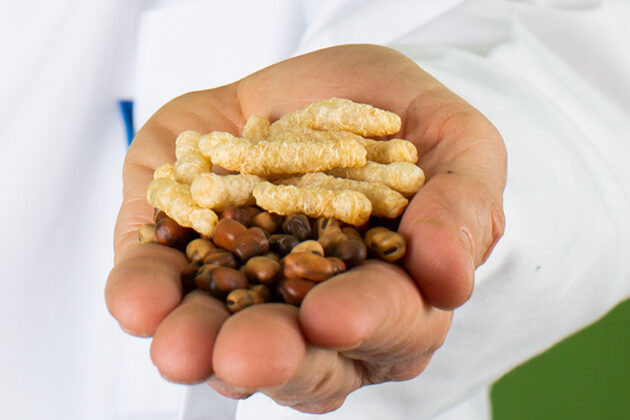GreenPlantFood
Green technology for plant-based food

A primary goal in this project is to contribute to restructuring the farm to fork food systems in Norway towards a more sustainable and “green” value chain.
Start
01. Apr 2021
End
31. Mar 2025
Funded by
The Research Council of Norway
Project Manager(s):
Other Participants:
Green technology for plant-based food (short named GreenPlantFood) is a collaborative project to meet challenges in society and industry financed by The Norwegian Research Council and the Food Industry (KSP 319049).

A shift towards increased use of plant food has positive effects on health and environment . To actually achieve this, there is a strong need to find and develop new, healthy, and attractive plant-based food products. We aim to do this mainly based on pulses and cereals grown in Norway.
About the project
To maintain national food self-sufficiency and employment, and competitiveness of the Norwegian agricultural sector and food industry there is need for more knowledge on the selection of suitable plant material combined with green technology processing. The main objective in this project is to facilitate green technology towards plant-based food in Norway with a significant proportion of Nordic Raw Materials into attractive and healthy products with low environmental footprint.

Furthermore, a project looking at extended utilisation of protein sources, needs to focus on their complete utilization, including side streams. Pulses (peas and faba beans), together with cereals (oat and barley), are realistic candidates for extended food uses as is, or as protein sources.
It is also a goal to find replacement for soya, which is imported and have a negative environmental footprint. Pulses are high-quality protein sources but contain a range of different compounds (polysaccharides, fat, polyphenols, anti-nutrients etc) that needs attention through green processing solutions.
Farmers and advisors will benefit from understanding which varieties to grow, the best suited regions and quality parameters sought by the Norwegian food industry for plant-based products.
“GreenPlantFood” will create value in the Norwegian plant food chain by, increasing the production of plant sources, developing production of healthy and attractive plant products and meals, create understanding how to overcome economic and social bottlenecks for increased production and sales and improve communication of scientific results and knowledge to industry, large supermarket chains, policy makers and consumers.
Work packages
1: Raw materials and quality assessments of ingredients
Establish methods for the analysis of important food quality parameters of raw materials, pre-processed and finished products to fulfil and monitor essential quality requirements. The WP is led by Svein Halvor Knutsen, Nofima.
2: Green food technologies towards ingredients
Implement green technologies for production of attractive plant-based protein-rich ingredients based on pulses and cereals. The WP is led by Stefan Sahlstrøm, Nofima.
3: New and improved food products
In close collaboration with WP1&2 identify possible new and attractive prototypes and products that can be tailored towards meal solutions that are healthy and sustainable. The WP is led by Catia Carmo, Nofima.
4: Added value of side streams and fractions
Methods for selective enrichment or removal of certain carbohydrate constituents and for specific use as ingredients as food and beyond. The WP is led by Bjørge Westereng, NMBU.
5: Agronomic potential and opportunities for Norwegian crops
The potential to increase the production of plant protein sources such as field peas and faba beans and how to achieve food grade quality shall be explored. The results will be taken further in WP6 for analyses of profitability for domestic producers and impacts on self-sufficiency. The WP is led by Anne Kjersti Uhlen, NMBU.
6: Economic, social and environmental sustainability benefits of plant food.
Assessment of the economic, social, and environmental sustainability of using the Norwegian produced plant products studied in WP1-5, both as fresh, unprocessed, and processed products, and including side streams. The WP is led by Anna Milford, Nibio.
7: Dissemination and communication of results
Facilitate an active effective consortium and communicate key findings to target audience, research communities, stakeholders, consumers, and authorities. The WP is led by Sveinung Grimsby, Nofima.
8: Project management
is led by Svein Halvor Knutsen, Nofima.
Novelty & expected impact
- Unique use of pulses and cereals and their protein fractions
- Creating meat analogues and other products from complex mixtures of ingredients rather than one single source
- Removing off flavours and off tastes by using dehulling, heat treatment and extractions
- Use of SFT technology to improve dry fractionation and to defat and deodorize products from pulses and cereals
- To implement information obtained in lab scale into pilot scale and industrial applications
- In vitro digestibility to quantitatively compare processed plant-based food
- Upgrade side streams to ingredients and food products to boost economic value to the whole plant food system for example by converting antinutrients to potential prebiotics.
Partners in the project
The project is led by Nofima.
Lantmännen Cerealia, AM Nutrition, Norgesmøllene, Hoff SA, Mills AS and FlowFood will collaborate in GreenPlantFood with the aim to optimize the use of protein and side stream fractions obtained from pulses, cereals, and potato in the project.
The academic partners: Nofima, NMBU, NIBIO, NORSUS, Technical University of Denmark (DTU) , Potsdam Institute for Climate Impact Research Germany (PIK), Instituto de Biologia Experimental e Tecnológica, Lisboa (iBET) and the University of food technologies Plovdiv, Bulgaria.

Film: What you need to make protein rich plant based products
This animated film shows you the equipment you need to make plantbased meat alternatives.
Nofima has the necessary equipment and knowledge.